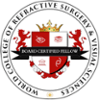Contrast Sensitivity Testing
What is it?
Contrast Sensitivity Testing measures your ability to clearly distinguish objects in low-contrast conditions. This is done by assessing how well you see the contrast between images in low-lighting conditions.
Not only does this provide important insight into your visual function at night, but it also gives your surgeon a better understanding of how you see things in the real world, as opposed to just black-and-white (100% contrast) letters on a chart.
This is important as some people may have normal or near-normal ‘black-on-white’ visual acuity but have poor vision in low lighting conditions. This may be a sign of reduced contrast vision.
How Does it Work?
In a contrast sensitivity test, you will be shown images of grey stripes, shapes or letters. The images are shown in a sequence with the contrast (the difference between object colour and background colour) continuously reduces, making it more difficult to distinguish the object clearly.
You will be challenged to recognise the object in each picture until you can no longer distinguish it from the background.
What are the Benefits?
As Laser Eye Surgery can temporarily affect your sensitivity to night disturbances, such as glare and halos, your surgeon needs to understand the quality of your pre-surgery contrast vision. This provides a clearer indication of how to plan your treatment to best avoid the occurrence of night vision disturbances.
For example, the use of ‘aspheric treatment profiles’ is generally safer concerning maintaining satisfactory night vision. Some laser systems used for Laser Eye Surgery are so effective that they can even improve contrast sensitivity and night vision in some patients.
What will I feel?
Contrast Sensitivity Testing is non-invasive, so you will feel nothing during this part of your assessment.


